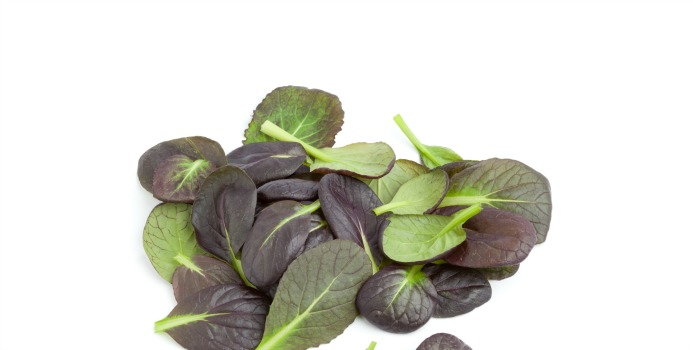Looking to add a new, flavorful, nutrient-powerhouse vegetable to your culinary repertoire? Look no further. Let me introduce you to Tatsoi.
Tatsoi is a tasty, spoon-shaped leafy green that looks somewhat like a cross between spinach and bok choy. Tatsoi’s taste is similar to spinach and has been described as sweet, tangy, mustardy, and earthy. With its delicate, creamy, sumptuous texture, tatsoi can be a delicious addition to a number of your favorite dishes. Tatsoi is also referred to as spinach mustard or spoon mustard.
Although Tatsoi originated in Japan and is native to China, it is becoming increasingly popular in the United States. It grows very quickly, is resilient, and will keep producing through most of the growing season.
Tatsoi Touts Powerful Nutrition
This dark leafy green packs a powerful nutrition punch. Tatsoi is chock-full of beta-carotene, vitamins C, K, and A, as well as iron, calcium, potassium, and phosphorus.
At a mere 22 calories per 100 grams, Tatsoi is very low in calories but provides 210 mg of calcium (21% Daily Value), 449 mg of potassium (13% Daily Value), 130 mg of vitamin C (217% Daily Value), 159 mcg of folate (40% Daily Value), and 9900 IU of vitamin A equivalent (198%). A 100-gram serving contains 2.2 grams of protein, 0.3 grams of fat, 3.9 grams of carbohydrates, and 2.8 grams of fiber (an impressive 11% Daily Value).
Tatsoi is also loaded with carotenoids, precursors to vitamin A, which are not only important for maintaining healthy eyesight and immunity but have been shown to help prevent cancer and heart disease. Tatsoi also houses glucosinolates, which are beneficial phytochemicals that may help you ward off certain types of cancer.
With twice as much calcium as milk, more vitamin C than oranges, and boatloads of phytochemicals, tatsoi deserves a place on your plate.
Tatsoi in the Kitchen
Tatsoi’s versatility makes it an incredibly easy new ingredient to play around with. You can toss the smaller leaves into a salad to add a quick punch of vibrant flavor and color. To keep it simple, you can use Tatsoi in any way you would use spinach.
Want to jazz up your stir-fry dishes? Toss some Tatsoi (baby or mature leaves) into the wok in the last minute--your taste buds will thank you. It also makes a great last-minute addition to your favorite soups for a boost of color, flavor, and nutrition. Use Tatsoi leaves as a bed for a brown rice pilaf or quinoa salad, or wilt the leaves with a warm salad dressing. It’s great paired with eggs and avocado. And don’t toss out those crunchy stalks—you can actually use these in place of celery.
You can try preparing Tatsoi my favorite way—briefly sautéed in a little bit of olive oil, onions, garlic, salt, pepper and a tiny splash of lemon juice for a simple yet delicious treat. Tatsoi’s subtle yet unique flavor makes it an ideal ingredient to keep on hand.
What about storage? Simply wrap the tatsoi leaves in a damp paper towel, place them in a plastic bag, and keep them in your fridge for 3-5 days.
Where Do I Find It?
You may not find Tatsoi in your typical grocery store, but you may be able to purchase it from healthy food stores, specialty grocery stores, or Asian markets (If you’re seeking it out at an Asian market, it might be labeled “tai koo choi”). Or, you can order seeds online and grow it yourself.
Kari Hartel, RD, LD is a Registered, Licensed Dietitian and freelance writer based out of St. Louis, MO. Kari is passionate about nutrition education and the prevention of chronic disease through a healthy diet and active lifestyle. Kari holds a Bachelor of Science in Dietetics from Southeast Missouri State University and is committed to helping people lead healthy lives. She completed a yearlong dietetic internship at OSF St. Francis Medical Center in Peoria, IL, where she worked with a multitude of clients and patients with complicated diagnoses. She planned, marketed, and implemented nutrition education programs and cooking demonstrations for the general public as well as for special populations, including patients with cancer, heart disease, diabetes, Alzheimer's disease, obesity, and school-aged children.



